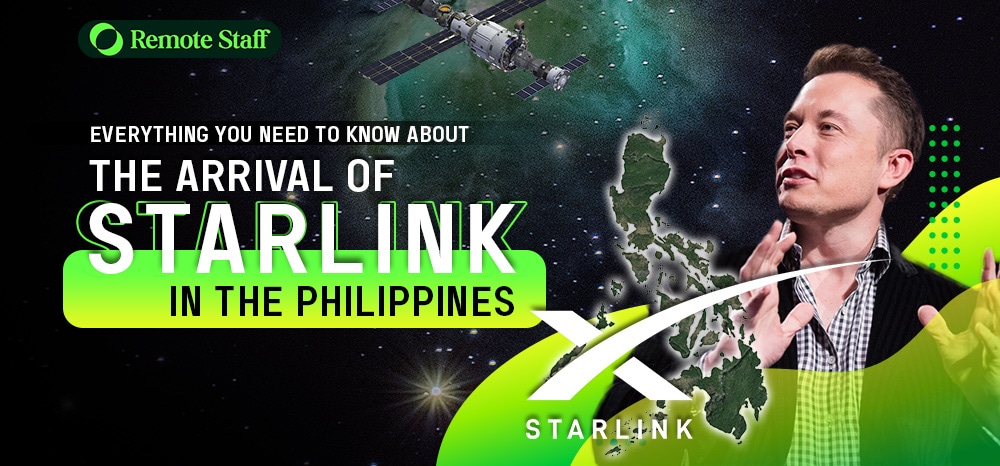Since remote work became the primary work setup for many Filipinos, the country’s internet connectivity issues have become more apparent. Aside from being slow, it’s also unreliable and even unavailable in many parts of the country, particularly in distant provinces.
To solve this issue, the government has embarked on various projects to provide better internet connectivity for the country.
Besides the planned undersea cable system project between Converge and Keppel, there’s also the launch of Starlink internet in the Philippines last February 22.
Starlink is the satellite internet provider owned by billionaire Elon Musk through his company Space Exploration Technologies Corporation (SpaceX).
There have already been talks between the government and Starlink to sell satellite internet in the Philippines since 2021. However, certain developments necessitated the postponement of Starlink’s launch in the Philippines to February 2023.
Other than fast internet speeds, Starlink also promises further coverage than our current internet connection options. The government hopes this will help provide internet connections to far-flung areas in the country and be especially useful to those working via online jobs.

What Makes Starlink Stand Out from Other Internet Providers?
Instead of using cable technology like fiber optics, Starlink uses low-orbiting satellites and radio signals to transmit internet data to its subscribers.
Although other companies, such as Viasat and Amazon, also utilize satellite-based internet services, Starlink uses thousands of smaller satellites instead of several large ones.
This technology allows Starlink to provide internet to even the most remote part of the Philippines. As well as offering impressive internet speeds too.
Starlink’s internet speed can reach over 200 Mbps while only having a latency as low as 20. That said, even though it offers a maximum of more than 200 Mbps, it doesn’t mean you’ll constantly get this speed.

How Much is It?
Unsurprisingly, with the amount of expensive technology that goes into Starlink, it doesn’t come cheap. The price for one unit alone is USD 599 or PHP 29,320. Then they have to pay PHP 2,700 after an initial 30-day trial.
In addition to the price of the hardware, you also have to consider transporting it to your location. It takes two to three weeks for your hardware to arrive after placing your order.
To see if your area is covered by Starlink, just head to their website here. Once there, you can check the availability of the satellite in your area. After inputting your location, you will also see an invoice listing how much you need to pay.

Is It Worth It, Then?
So, is Starlink worth it? If you live in a far-flung area that doesn’t have steady access to cable internet, definitely.
It offers a way for people in these areas to enjoy a fast and stable internet connection without waiting for telecom companies to set up their lines (which could be impractical in some locations, such as in the mountains).
However, since it’s still a relatively new technology, it still has reliability issues. If you’ve been working remotely for a long time, you may still want to get a backup internet connection, just in case.
In addition, the steep price could be off-putting to some. Besides paying almost thirty thousand pesos for the hardware, you also need to pay PHP 2,700 monthly to use it. That’s not something many Filipinos, especially in remote areas, can easily afford.
That said, the Department of Information and Communications Techo (DICT) assured the public that the government will shoulder most of the expenses for setting Starlink up in these remote communities.
Once these communities become self-sufficient enough to pay the subscription fees themselves, the government will slowly pass the expenses back to them.

Will a New Internet Service Provider Be the End of Our Internet Woes?
Internet connectivity has been a constant problem in the Philippines for a long time now. One of the main reasons for this is inadequate competition in the telecommunications industry.
This is why the government has allowed Starlink to operate in the Philippines.
Aside from providing healthy competition, Starlink offers something that current Philippine telecommunications companies currently don’t: fast and stable internet to remote areas in the country.
But does the arrival of Starlink mean the end of our internet issues? Not necessarily.
Although promising, there are still plenty of issues that need to be resolved. For one, Starlink’s internet connection isn’t always reliable (yet). And the cost of acquiring and subscribing to its services can be pretty steep too.
So while Starlink is a step in the right direction, there are still plenty of things to do before the Philippines’ internet issues are mostly solved.
With better internet comes better remote work opportunities. If you’re lucky enough to enjoy a stable connection and are looking for online jobs to apply to, Remote Staff is the place to go. Our jobs list has various online jobs for you to choose from. Good luck!

